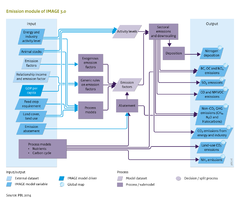Emissions/Policy issues: Difference between revisions
Jump to navigation
Jump to search
No edit summary |
No edit summary |
||
| Line 1: | Line 1: | ||
{{ComponentPolicyIssueTemplate | {{ComponentPolicyIssueTemplate | ||
|Reference=PBL, 2012; | |Reference=PBL, 2012; | ||
|Description=In a baseline scenario, most greenhouse gas emissions tend to increase, driven by an increase in underlying activity levels (Figure This is shown in Figure | |Description=In a baseline scenario, most greenhouse gas emissions tend to increase, driven by an increase in underlying activity levels (Figure This is shown in Figure below for a baseline scenario for the [[Roads from Rio+20 (2012) project|Rio+20]] study ([[PBL, 2012]]). For air pollutants, the pattern also depends strongly on the assumptions on air pollution control. In most baseline scenarios, air pollutant emissions tend to decrease, or at least stabilise, in the coming decades as a result of more stringent environmental standards in high and middle income countries. | ||
|Example=Policy scenarios present several ways to influence emission of air pollutants ([[Braspenning Radu et al., in preparation]]): | |Example=Policy scenarios present several ways to influence emission of air pollutants ([[Braspenning Radu et al., in preparation]]): | ||
* Introduction of climate policy, which leads to systemic changes in the energy system (less combustion) and thus, indirectly to reduced emissions of air pollutants ([[Van Vuuren et al., 2006]]). | * Introduction of climate policy, which leads to systemic changes in the energy system (less combustion) and thus, indirectly to reduced emissions of air pollutants ([[Van Vuuren et al., 2006]]). | ||
| Line 8: | Line 8: | ||
* Assumptions related to soil and nutrient management. The major factors are fertiliser type and mode of manure and fertiliser application. Some fertilisers cause higher emissions of N2O and NH3 than others. Incorporating manure into soil lowers emissions compared to broadcasting. | * Assumptions related to soil and nutrient management. The major factors are fertiliser type and mode of manure and fertiliser application. Some fertilisers cause higher emissions of N2O and NH3 than others. Incorporating manure into soil lowers emissions compared to broadcasting. | ||
The impacts of more ambitious control policies ({{abbrTemplate|CLE}} versus {{abbrTemplate|EKC}}) on SO2 and NOx, emissions, and the influence of climate policy are presented in Figure below. Where climate policy is particularly effective in reducing SO2 emissions, air pollution control policies are effective in reducing NOx emissions. | The impacts of more ambitious control policies ({{abbrTemplate|CLE}} versus {{abbrTemplate|EKC}}) on SO2 and NOx, emissions, and the influence of climate policy are presented in Figure below. Where climate policy is particularly effective in reducing SO2 emissions, air pollution control policies are effective in reducing NOx emissions. | ||
}} | }} | ||
Revision as of 13:49, 21 May 2014
Parts of Emissions/Policy issues
| Component is implemented in: |
Components:and
|
| Projects/Applications |
| Models/Databases |
| Key publications |
| References |
